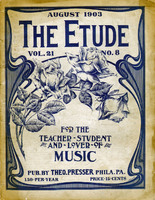BY DR. HENRY W. GILES.
KUBELIK, the celebrated violinist once said: “Man longs for something—he don’t know what it is; I supply that want.” He might have named the composer as coadjutor with himself in filling this want. Apropos of Kubelik’s statement we might consider the question: does “man’s wants” in these particulars change with the years, and what is it that he desires to-day? Not so many years ago Wagner was considered the advance guard in modern music, yet the “music of the future” can hardly be called Wagnerian to-day. The truth is that we have and probably always will have some composers who are writing ahead of their time—not for everybody perhaps, but at least for some of the critics.
The spirit of the age is interrogative. We are continually asking questions—whence, whither, wherefore? The thinking that the individual was in the habit of delegating to his lawyer, doctor, or minister, he now does largely himself. It is not strange that this spirit should permeate musical art. Then, again, our nervous systems are higher strung and demand a stimulant where previously a sedative was indicated. This spirit of inquiry and unrest the modern composer expresses by making frequent modulation, the use of dissonant harmonies, striking and frequently changing rhythms, and a spare and infrequent use of the perfect and other cadences which tend to establish the key-sense, or sense of tonality. In other words, to quote an author, “the music is always promising, never performing.” In so doing the modern writer is only following in the path broken by Richard Wagner forty or fifty years ago.
It is true that Wagner’s “endless recitative,” as a renaissance of the earlier forms, was in a sense a retrograde movement, yet his treatment of it was entirely new, and expressive of the intellectuality of his age. The sturdy critic of to-day pokes his fun at Richard Strauss and composers of that ilk, little thinking that he is simply a living verification of Solomon when he said “there is nothing new under the sun;” for they did the same thing to Beethoven and Wagner in turn. No, these latter-day composers are simply writing up to the spirit of the age-it may be beyond it perhaps; nevertheless whatever is good will be retained, the rest will sink into oblivion. The old cry about “melody” or “no melody” is worn out. Music without melody it is impossible to conceive—only it must be remembered that tastes differ as to the character of the same. The uneven and changing rhythms represented by 7/4 or 5/4 time of perhaps only a measure or two or perhaps an entire movement, is characteristic of a prevailing feeling of unrest or spirit of interrogation. Nothing, however, expresses this mental attitude better than the deceptive cadence with which modern music is honeycombed. The use of the augmented and diminished intervals, and frequent inharmonic changes is simply a stimulant with a higher degree of biting power—it is tabasco rather than black pepper.
The libretto of “Don Giovanni” is intensely dramatic in parts, yet the music written to these parts by Mozart would be voted exceedingly tame to-day. The diminished seventh chord at that time was considered highly dramatic—at present our nervous systems respond but feebly to this stimulus. Then the chord of the augmented sixth was to be used only under certain conciliating circumstances—now major sevenths and augmented octaves are pleasantly disagreeable, and we are ready for a change of rhythm every third measure.
It is, however, in the scoring for orchestra that the modern composer expresses his individuality in the extreme. The string portion of the orchestra remains about the same as when first instituted. It is true the number of independent voices allotted to the strings has been increased, but it is in the wind and percussion instruments that the greatest changes are observed. Our nervous systems respond only to about double the power of the old orchestras. Hence where a pair of the brass or wood-wind sufficed for Beethoven, to-day we require three and four. The strings can only express a certain amount of plenitude of vibration, but, by increasing the number of brass and wood-wind, the power is almost unlimited.
That the capacity of the laity to hear, receive, and appropriate musical ideas has increased enormously of late we have abundant and convincing proof. As a single instance take Wagner’s “Tristan und Isolde.” It is not many years ago that the beauties of this work were a sealed book to the great majority. To-day the political editor of one of our great weeklies goes to his desk from a performance of this work and writes a panegyric on Wagner in general and this opera in particular.
Just what part music is to assume in the mental and spiritual evolution of man no one can tell. That its influence is already large and continually increasing, no one can gainsay. Its language is infinitude itself. Is it not possible that a further revelation of the mind, attributes, and our relation to Deity may take place through the medium of the tonal art?



